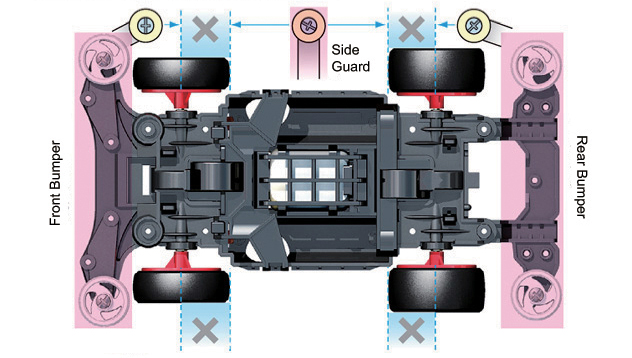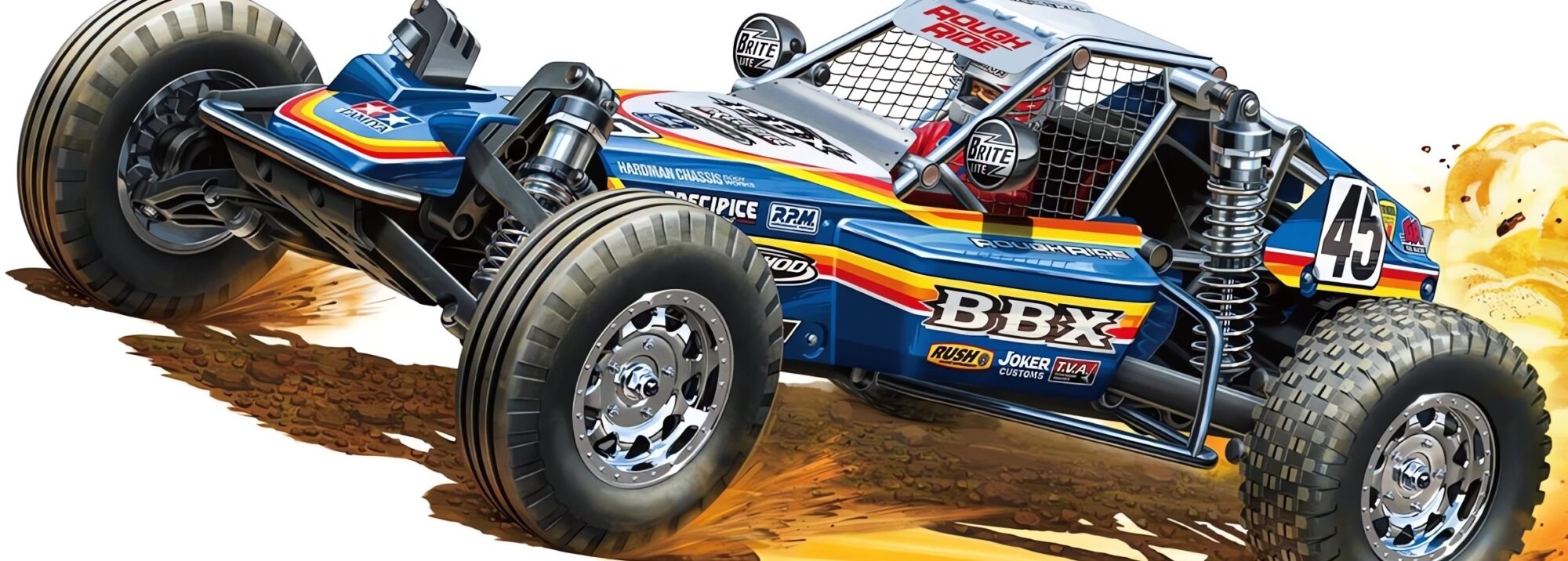Tamiya hereby announces changes to the regulations for Tamiya Official Mini 4WD races in Japan, which are provisionally to be in force for 2018 New Year and Spring races.
In order to keep Tamiya’s Mini 4WD race competitions fun, exciting, and fair, we have developed a set of competition regulations. All participants of official Mini 4WD race events are required to abide by these regulations.
Mini 4WD races are not just about being the fastest, it’s also about using your head and having good set-up techniques. Not only do you challenge other racers, but you challenge yourself too. By remembering the spirit of fair play, you can learn how to race honorably and with good manners. Therefore, we hope that every Mini 4WD fan will abide by these regulations.
※Latest changes (December 2017): Section 3: Machine Measuring System
★The limit on the number of rollers (was previously 6) has been removed.
★The limits on positioning of rotating mass dampers have been removed.
Please note that these special rules will provisionally apply to 2018 New Year and Spring races only. An announcement about their continuation or otherwise will be made at a later date.
【1】Machines
1. Usable Machine Types
Only Mini 4WD REV, Mini 4WD PRO, Racing Mini 4WD, Super Mini 4WD, Fully-Cowled Mini 4WD, Aero Mini 4WD, Mighty Mini 4WD, R/C Mini 4WD, and Truckin’ Mini 4WD machines are permitted. Further restrictions on machine types may be possible depending on the race event or race class.
2. Machine Assembly
All machines must be four-wheel drive. Modifications that result in rear-wheel or front-wheel drive are prohibited. Bodies should have stickers applied or be painted, and must be securely attached to the chassis. Please be warned that bodies which are particularly small, or those which it is difficult to check are painted or have stickers applied, may be prohibited. Home-made bodies are prohibited. All machines must go through car inspection and machines that do not pass inspection cannot participate in the race. As a general rule, machines must be assembled by the racer. Some exceptions may be applied. Please ask Race Officials.
3. Machine Measuring System
All machines must have a 4WD setup and will be subject to the same measuring system as shown below.

Maximum Car Width: Under 105mm
Overall Car Height: Under 70mm
Overall Car Length: Under 165mm
Minimum Ground Clearance: At least 1mm
Minimum Car Weight (including batteries and motor): At least 90g
Front and Rear Tires: Diameter: 22-35mm, Width: 8-26mm (Note that tires must be attached.)
Rollers: There is no limit on the amount of rollers that can be used.
(★Effective for 2018 New Year & Spring races)
Mass Dampers: The installation positions of rotating mass dampers are no longer limited.
(★Effective for 2018 New Year & Spring races)
When adding parts to the bumpers, side guards or the chassis, please note the zone restrictions below.
※Definition of Bumpers – For MS chassis, the bumper is the section on the Front or Rear Unit not including the Bumperless Unit. On other chassis, bumpers are the sections forward and rearward of the front and rear gearboxes respectively.
※Definition of Side Guards – Parts that extend from the sides of the chassis between the front and rear tires.

Parts which extend around the outside of the wheels to completely frame the chassis are not allowed.
Parts attached to the front bumper cannot extend past the line of the front axle.
Parts attached to the rear bumper cannot extend past the line of the rear axle.
Parts attached to the side guards must remain within the lines shown: (back edge of Front Tire & front edge of Rear Tire)
Chassis: Extension parts which are attached to the chassis itself are subject to the same zone restrictions as similar parts attached to the bumpers or side guards.
※There are no rules for parts which pass above or within the outside edges of the tires.
※There are no rules for mounting rollers, etc. to the body as long as they are above the level of the wheel axles. If they extend below this line, they will be subject to the same limits as parts which are attached to side guards.
4. Motor
Machines may use the kit-included normal motor, Rev-Tuned Motor, Torque-Tuned Motor, Atomic-Tuned Motor, Sprint-Dash Motor, Power-Dash Motor, Hyper-Dash 2 Motor, Hyper Mini Motor, Light-Dash Motor, Hyper-Dash 3 Motor, Rev-Tuned 2 Motor, Torque-Tuned 2 Motor and Atomic-Tuned 2 Motor. Mini 4WD PRO machines may only use the kit-included normal motor or motors designed for use with the Mini 4WD PRO series.
Depending on the race event, other Tamiya motors may be permitted.
For speed-limited race events or classes, if your speed exceeds the allowed limit, even the above motors may not be installed.
Disassembling the motor to change the number of coils and other such illegal modifications are prohibited.
If there are indications that the motor cap has been detached, it will be judged as being illegally modified.
5. Batteries
Only Tamiya-branded R6/AA/UM3 batteries are permitted. R/C Mini 4WD cars and TR-1 chassis cars may use alkaline batteries only. If the battery appears to be damaged in any way, they will not be accepted for safety reasons. Please note that some events may have different rules regarding which types or brands of batteries can be used.
6. Modifications
Please follow the guidelines below when modifying your car. Also note that for modifications not listed, race officials will have the final absolute authority to grant or deny their use.
- Chassis modifications are limited to cutting away plastic material or cutting holes out of the stock chassis. Homemade chassis and homemade parts are prohibited.
- Parts used for modification are limited to Tamiya Mini 4WD, R/C Mini 4WD, and Dangun Racer parts only.
- Part modifications are limited to cutting away the material or making holes in the stock part.
[NOTE] Original part shape must be clearly identifiable.
In the following cases, it will be considered that the original part shape is not identifiable:
※Modifications to the part shape on carbon plates, FRP plates or metal parts (including modifications to shaft or pin shape).
In the following cases, it will be considered that the original part shape is identifiable:
※Modifications to parts that keep the original part shape, such as simply cutting away the material, or enlarging or adding parts attachment holes.
※Opening holes or painting on the top side of the rollers.
※Modifying or cutting tire material (changing the material properties of the tire surface is prohibited. Combining different sizes or materials of tires is allowed. However, please make sure that they do not fall apart during running).
※Using motor parts is allowed (motor disassembly is not recommended).
4. Gear modifications are limited to making holes or shaving away material to reduce weight and installing ball bearings. All running gears must be installed according to the set gear ratios.
5. Only kit-included battery terminals or Grade-Up Part battery terminals, installed according to the instruction manuals, may be used. Soldering or double-plated terminals are prohibited.
6.Modifications that cause physical harm to the track, cause injury to any person, or release grease and/or other substances onto the track are all prohibited.
7. Modifications to the tire’s shape are allowed if they comply with the Car Measuring System outlined above. However, changing the material properties of the tire surface (including, but not limited to, applying glue or other substances to the tire surface) are prohibited.
【 2 】 Race Courses
For courses which satisfy the below specifications and are sanctioned by Tamiya, times recorded during races will be officially recognized. All times recorded on original courses that do not meet these requirements will be considered unofficial.
Individual Lane Width: 115mm (measured on a straight section)
Course Wall Height: 50mm (measured from road surface)
Adjusting the height and lane width of lane change sections, bank turn sections, etc. for smoother racing operations is permitted.
【 3 】 For Competitions at Official Race Courses
The start of the race will be indicated by a signal from a Tamiya race official or a starting signal system. Racers will switch on their cars, hold them in the air with one hand, and drop them vertically into their assigned lane at the start signal. Throwing or pushing the car forward is prohibited.
A racer will immediately retire from a race if their car leaves the track, flips over, jumps into another lane, or if their car’s body detaches during the race.
If race officials determine that a racer’s car is blocking the progress of faster machines, the racer will be required to retire.
A car’s race is completed when it reaches the finish line.
Qualifying and Final positions are determined by either the race finishing order or Time Attack time.
【 4 】 Car Inspection
All racers must have their car inspected by race officials before the race. If any part of the car is determined to be against race regulations, the racer must make the necessary changes in order to participate in the race.
From the time the car passes the car inspection to when the race begins, the car’s settings must not be changed and no modifications can be made.
In addition to the pre-race car inspection, other car inspections may occur at any time during the race day at the race official’s discretion. If the car is found to be in violation of the race regulations at any of these inspections, the racer’s race results up to that point will be disqualified and the racer must make necessary changes in order to participate in subsequent races.
If a machine does not pass car inspection, and cannot be made race-legal, the participant can still take part in the Qualifying rounds for their own benefit, but their times will not be recorded.
【 5 】 Disqualification
If any of the following situations occur, race officials will, at their discretion, have absolute authority to disqualify any racer. Please take care to remember the common manners for a Mini 4WD race to avoid any problems.
A racer’s car is determined to have modifications that will cause physical harm to other racers, other cars, or the race track.
A racer’s car is determined to have modifications that are designed to deliberately obstruct other cars.
A racer deliberately puts grease or other substances onto the track to affect track surface conditions.
A racer is determined to have modified their car after it had passed the car inspection.
A racer is determined to have deliberately touched the track or cars to impede other racers’ race progress.
A racer does not follow the instructions of race officials or otherwise impedes the operations of the race track.
A racer has a false start, or is determined to have thrown or pushed their cars forward at the start of a race.
A racer is determined to have acted against the spirit of fair play or caused distress to other participants.
【 6 】 Race Operations
Participants may raise objections to the race officials. However, these objections must be made before the next race begins.
Race officials reserve the right to announce the use of special regulations at any time during the race.
【 7 】 Participant Restrictions
Please be aware that some races have age limitations, so it may be that some participants cannot take part in certain classes or races.
Except for endurance races, it is against regulations to have more than 2 racers using the same car.

Good day, I m looking for a 4 WD 1:32 model that provided dimensions and mass of each part of the components.